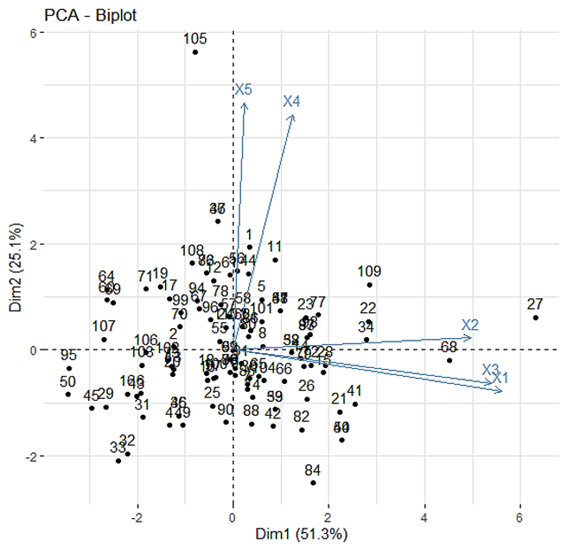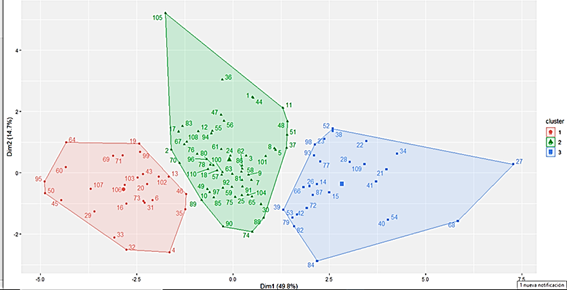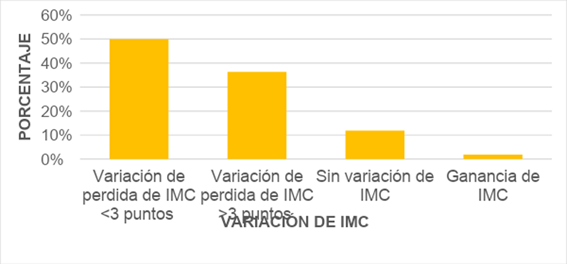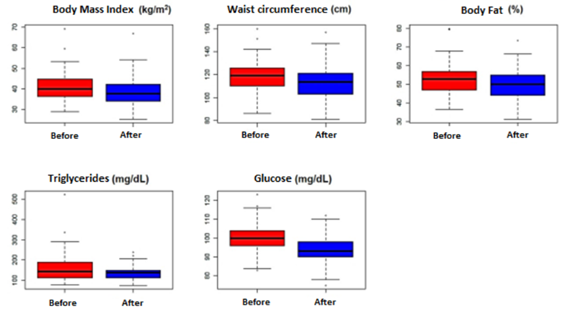Servicios Personalizados
Revista
Articulo
Indicadores
-
 Citado por SciELO
Citado por SciELO
Links relacionados
-
 Similares en
SciELO
Similares en
SciELO
Compartir
Revista de la Facultad de Medicina Humana
versión impresa ISSN 1814-5469versión On-line ISSN 2308-0531
Rev. Fac. Med. Hum. vol.23 no.3 Lima jul./set. 2023 Epub 21-Sep-2023
http://dx.doi.org/10.25176/rfmh.v23i3.5572
Original Article
Characterization of diet in biochemical and anthropometric profiles with principal component analysis in obese patients, Guayaquil - Ecuador
1Universidad Peruana Unión. Lima, Peru
Objectives:
To determine the characterization of the diet in biochemical and anthropometric profiles with principal component analysis in obese Ecuadorian patients.
Methods:
Descriptive, comparative, longitudinal studies; we had access to the institutional health clinical history database and a study group was formed, they were offered a low-carbohydrate diet. The sample consisted of 110 obese patients from the Hospital of Guayaquil-Ecuador.
Results:
The patients were between the ages of 25 to 65 years. The results showed a significant loss of BMI (kg/m2) (Δ-2.6±1.9) (p<0.001), waist circumference (cm) (Δ-5.1±4.7) (p<0.001), body fat (%) (Δ-3.6±3.6) (p<0.001), triglycerides (mg/dL) (Δ-25.4±72.9) (p<0.001) and glucose (mg/dL) (Δ-6.8±9.6) (p<0.001).
Conclusion:
The low carbohydrate diet reduces BMI, waist circumference, body fat, triglycerides and glucose in obese patients.
Keywords: Diet; Anthropometry; Biomarkers; Obesity (source: DeCS BIREME)
INTRODUCTION
According to the World Health Organization1, non-communicable chronic diseases cause the death of 41 million people each year, accounting for 71% of deaths and occurring in individuals aged 30 to 69 in low-to middle-income countries. In the Americas, non-communicable diseases (NCDs) account for 81% of all deaths, with 39% of them being premature deaths in individuals aged 30 to 70. The leading causes of death are cardiovascular diseases (34.9%), cancer (24.3%), diabetes (6.2%), and other causes (25.7%)2.
Over the past decades, the prevalence of obesity has been on the rise, defined as having a body mass index (BMI) greater than 30 kg/m2, particularly in developing Western societies3. Obesity can generally be considered a chronic, progressive, and recurring disease4, and a major risk factor for global mortality.
Low-carbohydrate diets have been associated with favorable effects on cardiovascular risk factors and body weight5,6. Some research shows a direct association between low-calorie food intake and decreased risk of mortality, diabetes, inflammation, and other conditions7, leading to a better proportion of calories from proteins and fats and improved satiety8. This would restore the metabolic inflexibility caused by the accumulation of fatty acids9and thus reduce the risk of developing non-communicable chronic diseases.
Low-carbohydrate diets have been used to treat obesity and type 2 diabetes mellitus for many years, and there is evidence regarding their safety and efficacy10, although they have received little attention in clinical research studies until recently11.
There are few studies on the effect of low-carbohydrate diets in obese patients. Therefore, the objective of this research is to determine the characterization of the diet in biochemical and anthropometric profiles using principal component analysis in obese patients from the city of Guayaquil, Ecuador.
METHODS
Study Location
Access was obtained to the database of the institutional medical records of obese patients attending the outpatient nutrition service of a hospital in the city of Guayaquil, Ecuador, in 2022. The study group consisted of patients who received a low-carbohydrate diet.
Population and Sample
The study population consisted of all male and female patients aged between 24 and 74 years attending the outpatient clinic of a hospital in Guayaquil, Ecuador, with a diagnosis of Obesity due to excess calories and other types of obesity. The sample comprised 110 patients, selected through convenience sampling.
Inclusion Criteria:
Patients attending outpatient clinics with overweight and obesity referred by other health units and from medical referrals with different hospital services.
Patients with recorded anthropometric data including weight, height, BMI, waist circumference, and body fat percentage.
Patients with recorded biochemical data including blood glucose and triglyceride levels.
Patients who voluntarily agreed to participate in the study.
Exclusion Criteria:
Patients with overweight and obesity who have a diagnosis of type 2 diabetes mellitus and other comorbidities not related to the study.
Patients who declined to participate in the study.
Variables:
Independent Variable:
Low-carbohydrate diet, defined as a diet contributing <130g/d(12).
Dependent Variables:
Anthropometric indicators including body mass index (BMI), with values of 25-29.9 kg/m2 indicating overweight and ≥30 kg/m2 indicating obesity according to the World Health Organization1; abdominal circumference (cm) with normal values of <90 cm for men and <80 cm for women according to the International Diabetes Federation (IDF) criteria; body fat percentage calculated using equations: Men: 63 - (20 x height/circumference), normal range: 18-24; Women: 76 - (20 x height/circumference), normal range: 25-31. Biochemical indicators include triglycerides (mg/dl) and fasting blood glucose levels (mg/dl), analyzed using Trinder's colorimetric reagent kits13.
Procedures:
Data was collected from November 2021 to January 2022, including variables such as age and sex. The patients followed the low-carbohydrate diet for 3 months, and the data were recorded in an Excel file for subsequent analysis using RStudio and SPSS version 25.
Statistical Analysis:
Statistical analysis was conducted using RStudio program. Descriptive analysis of the data was performed. Principal Component Analysis (PCA) was conducted using R programming environment version 3.5.1 and the libraries FactoMineR and factoextra14to simplify the set of interrelated variables and perform cluster analysis. Wilcoxon test was used to determine the effect of the low-carbohydrate diet on the biochemical and anthropometric indicators of Ecuadorian obese patients.
RESULTS
The participants consisted of 103 women (93.6%) and 7 men (6.4%) aged between 25 and 65 years. The individuals were analyzed for their correlation with the study variables (Figure 1), where it is observed that the cumulative variance percentage in the first two dimensions is 76.4%, which is considered adequate for interpreting PCA results.
Dimension 1: The group of individuals including 109, 40, 54, 84, 68, 27, and 22 showed high values for body fat percentage, BMI, and waist circumference. The group including 50, 45, 32, 95, and 33 showed low values for waist circumference, BMI, body fat percentage, and triglycerides. Additionally, it can be observed that Dimension 1 is mainly represented by variables x1, x2, and x3.
Dimension 2: The group of individuals including 105, 36, and 47 showed high values for triglycerides, while the group including 50, 45, 32, 95, and 33 showed low values for waist circumference, BMI, body fat percentage, and triglycerides. Overall, Dimension 2 is mainly represented by variables x4 and x5.

Figure 1. Individual Analysis Note: X1: IMC (kg/m2), X2: Waist circumference (cm), X3: Body fat percentage (%), X4: Triglycerides (mg/dL), X5: Glucose (mg/dL)
Regarding the hierarchical classification, three groups were obtained (Figure 2). The first group consists of individuals such as 32, 45, 50, 60, 64, and 95. This group is characterized by low values for waist circumference (before and after treatment), body fat percentage (before and after treatment), BMI (before and after treatment), triglycerides (before and after treatment). The second group consists of individuals such as 1, 4, 36, 44, and 105. This group is characterized by high values for triglycerides and glucose, and low values for BMI (before and after treatment). Lastly, the third group consists of individuals such as 27, 34, 68, and 84. This group is characterized by high values for BMI (before and after treatment), body fat percentage (before and after treatment), and waist circumference (before and after treatment).
In Figure 3, it is shown that 86.36% of the patients experienced significant changes in the Quetelet index over the three-month period, as indicated in Figure 3.
In Figure 4, it can be observed that the values of BMI, waist circumference, body fat, triglycerides, and glucose decrease when comparing the medians before and after the low-carbohydrate diet.
The Wilcoxon test, a non-parametric statistic, was used to compare the means of the study variables and determine if there were significant changes before and after the low-carbohydrate diet treatment. It can be observed that the changes occur at a significance level of 5% in obese patients (Table 1).
Table 1. Results of the Wilcoxon test for the study variables before and after
| Variables | Initial | Final | Diference | p-value |
| BMI (kg/m2) | 40,7 ± 6.7 | 38,1 ± 6,8 | 2.6 ± 1,9 | 0.000 |
| Waist circumference (cm) | 118,1 ± 13,2 | 112,9 ± 13.6 | 5.1 ± 4,7 | 0.000 |
| Body fat percentage (%) | 52,9 ± 7,7 | 49,4 ± 7,7 | 3.6 ± 3,6 | 0.000 |
| Triglycerides (mg/dL) | 161,8 ± 66,4 | 136.4 ± 31,3 | 25.4 ± 72,9 | 0.002 |
| Glucose (mg/dL) | 100,3 ± 7,2 | 93,5 ± 7,7 | 6.8 ± 9,6 | 0.000 |
DISCUSSION
The research demonstrated that a low-carbohydrate diet over a period of 3 months resulted in decreased levels of triglycerides, BMI, waist circumference, body fat, and glucose in obese patients. Other studies conducted in obese individuals also showed significant changes in biochemical parameters such as triglycerides, cholesterol, and weight loss after consuming a low-carbohydrate diet for 6 to 12 months15,16,17. Similarly, Gordillo et al.18found significant reductions in BMI and waist circumference in individuals at risk of diabetes who followed a low-carbohydrate diet for 6 months, which aligns with the results observed in obese patients over a 3-month period.
Although nutrition is a modifiable risk factor, many individuals with obesity do not adhere to dietary recommendations due to eating habits that are associated with emotional aspects and eating disorders19. Additionally, the availability and access to food, particularly processed products, contribute to increased consumption of foods high in simple sugars and saturated fats, which are associated with overweight, obesity, and the risk of morbidity and mortality from chronic degenerative diseases. This consumption increases the risk of overweight, obesity, hypertension20,21,22, and a high prevalence of metabolic syndrome associated with the consumption of ultra-processed foods23.
On the other hand, a study by Krebs et al. found that diabetic patients who followed a low-carbohydrate, high-fat diet for 24 weeks experienced significant weight loss24,25and improvements in biochemical parameters such as triglycerides and glucose24, which is consistent with the findings of the current study involving obese patients on a low-carbohydrate diet for 3 months. Similarly, a retrospective study of a group of obese patients with diabetes mellitus who switched from a high-carbohydrate diet (55-60%) to a diet consisting of 20% carbohydrates, 30% protein, and 50% fat showed significantly superior results after 6 months of treatment26.
Another study identified a significant reduction in triglyceride levels after 3 months of low-carbohydrate diet treatment in diabetic patients27, similar to the results observed in our study involving obese patients over a 3-month period. Currently, dietary recommendations for individuals with obesity are not being followed or adhered to. The effect of a low-carbohydrate diet is important due to its greater adherence and association with a lower risk of cerebrovascular diseases28, while a diet that induces increased glucose levels is associated with a higher risk of coronary heart disease29. Weight gain also increases vulnerability to chronic diseases, leading to disability and a decrease in life expectancy30.
The study did not record the physical activity levels of the patients, which may introduce bias, as patients may have engaged in physical activity with the intention of losing weight. The results may not be generalizable to other contexts and populations.
REFERENCES
1. OMS. INFORME-STEPS. 2018. Disponible en: https://www.salud.gob.ec/wp-content/uploads/2020/10/INFORME-STEPS.pdf [ Links ]
2. PAHO. Prevención y control de las enfermedades no transmisibles. 2017. Disponible en: https://www.paho.org/es/temas/enfermedades-no-transmisibles [ Links ]
3. James WP. Obesity-a modern pandemic: the burden of disease. Endocrinol Nutr. 2013;60 Suppl 1:3-6. doi: 10.1016/s1575-0922(13)70015-94. [ Links ]
4. Bray GA, Kim KK, Wilding JPH; World Obesity Federation. Obesity: a chronic relapsing progressive disease process. A position statement of the World Obesity Federation. Obes Rev. 2017;18(7):715-723. doi: 10.1111/obr.12551 [ Links ]
5. Sackner-Bernstein J, Kanter D, Kaul S. Dietary Intervention for Overweight and Obese Adults: Comparison of Low-Carbohydrate and Low-Fat Diets. A Meta-Analysis. PLoS One. 2015;10(10): e0139817. Published 2015 Oct 20. doi: 10.1371/journal.pone.0139817 [ Links ]
6. Santos FL, Esteves SS, da Costa Pereira A, Yancy WS Jr, Nunes JP. Systematic review and meta-analysis of clinical trials of the effects of low carbohydrate diets on cardiovascular risk factors. Obes Rev. 2012;13(11):1048-1066. doi: 10.1111/j.1467-789X.2012. 01021.x [ Links ]
7. Buyken AE, Goletzke J, Joslowski G, et al. Association between carbohydrate quality and inflammatory markers: systematic review of observational and interventional studies. Am J Clin Nutr. 2014;99(4):813-833. doi: 10.3945/ajcn.113.074252 [ Links ]
8. Weigle DS, Breen PA, Matthys CC, et al. A high-protein diet induces sustained reductions in appetite, ad libitum caloric intake, and body weight despite compensatory changes in diurnal plasma leptin and ghrelin concentrations. Am J Clin Nutr. 2005;82(1):41-48. doi: 10.1093/ajcn.82.1.41 [ Links ]
9. Fechner E, Bilet L, Peters HPF, et al. Effects of a whole diet approach on metabolic flexibility, insulin sensitivity and postprandial glucose responses in overweight and obese adults - A randomized controlled trial. Clin Nutr. 2020;39(9):2734-2742. doi: 10.1016/j.clnu.2019.12.010 [ Links ]
10. Churuangsuk C, Kherouf M, Combet E, Lean M. Low-carbohydrate diets for overweight and obesity: a systematic review of the systematic reviews. Obes Rev. 2018;19(12):1700-1718. doi: 10.1111/obr.12744 [ Links ]
11. Alberti KG, Zimmet P, Shaw J; IDF Epidemiology Task Force Consensus Group. The metabolic syndrome--a new worldwide definition. Lancet. 2005;366(9491):1059-1062. doi: 10.1016/S0140-6736(05)67402-8 [ Links ]
12. Noakes TD, Windt J. Evidence that supports the prescription of low-carbohydrate high-fat diets: a narrative review. Br J Sports Med. 2017;51(2):133-139. doi: 10.1136/bjsports-2016-096491 [ Links ]
13. Deurenberg P, Weststrate JA, Seidell JC. Body mass index as a measure of body fatness: age- and sex-specific prediction formulas. Br J Nutr. 1991;65(2):105-114. doi: 10.1079/bjn19910073 [ Links ]
14. Lê, S., Josse, J., & Husson, F. (2008). FactoMineR: An R Package for Multivariate Analysis. Journal of Statistical Software, 25(1), 1-18. https://doi.org/10.18637/jss.v025.i01 [ Links ]
15. Goldenberg JZ, Day A, Brinkworth GD, Sato J, Yamada S, Jönsson T, Beardsley J, Johnson JA, Thabane L, Johnston BC. Efficacy and safety of low and very low carbohydrate diets for type 2 diabetes remission: systematic review and meta-analysis of published and unpublished randomized trial data. BMJ. 2021;372:m4743. doi: 10.1136/bmj.m4743. [ Links ]
16. Barber TM, Hanson P, Kabisch S, Pfeiffer AFH, Weickert MO. The Low-Carbohydrate Diet: Short-Term Metabolic Efficacy Versus Longer-Term Limitations. Nutrients. 2021 ;13(4):1187. doi: 10.3390/nu13041187. [ Links ]
17. Feinman RD, Pogozelski WK, Astrup A, et al. La restricción de carbohidratos en la dieta como primer enfoque en el manejo de la diabetes: revisión crítica y base de evidencia. Nutrición 2015; 31: 1-13. 10.1016 / j.nut.2014.06.011 [ Links ]
18. Gordillo-Cortaza JDR, Pozo-Verdesoto SD, Sanclemente-Lainez GK, Viteri-Gómez GR, Gómez-Rutti YY, Feraud-Ibarra FV, Vásquez- Rodríguez NA, González-García WA, Poveda-Navarrete S. Efecto de fluoxetina y dieta baja en carbohidratos en marcadores de riesgo cardiometabólico en sujetos con riesgo de diabetes mellitus. RevistaUG; 2021;132(1):10-2. Disponible en: https://revistas.ug.edu.ec/index.php/rug/article/view/1352 [ Links ]
19. Micanti F, Iasevoli F, Cucciniello C, Costabile R, Loiarro G, Pecoraro G, et al. The relationship between emotional regulation and eating behaviour: a multidimensional analysis of obesity psychopathology. Eat Weight Disord EWD. marzo de 2017;22(1):105-15. [ Links ]
20. Canhada SL, Luft VC, Giatti L, Duncan BB, Chor D, Fonseca M de JM da, et al. Ultra-processed foods, incident overweight and obesity, and longitudinal changes in weight and waist circumference: the Brazilian Longitudinal Study of Adult Health (ELSA-Brasil). Public Health Nutr. abril de 2020;23(6):1076-86. [ Links ]
21. Rezende-Alves K, Hermsdorff HHM, Miranda AE da S, Lopes ACS, Bressan J, Pimenta AM. Food processing and risk of hypertension: Cohort of Universities of Minas Gerais, Brazil (CUME Project). Public Health Nutr. septiembre de 2021;24(13):4071-9. [ Links ]
22. Sartorelli DS, Crivellenti LC, Zuccolotto DCC, Franco LJ. Relationship between minimally and ultra-processed food intake during pregnancy with obesity and gestational diabetes mellitus. Cad Saúde Pública. 2022;35. Disponible en: http://www.scielo.br/j/csp/a/Z8PQFxyCc8mzSn6txQsq4gq/?lang=en [ Links ]
23. Martínez Steele E, Raubenheimer D, Simpson SJ, Baraldi LG, Monteiro CA. Ultra-processed foods, protein leverage and energy intake in the USA. Public Health Nutr. enero de 2018;21(1):114-24. [ Links ]
24. Krebs JD, Bell D, Hall R, et al. Improvements in glucose metabolism and insulin sensitivity with a low-carbohydrate diet in obese patients with type 2 diabetes. J Am Coll Nutr. 2013;32(1):11-17. doi: 10.1080/07315724.2013.767630 [ Links ]
25. Hernández Alcantara G, Jiménez Cruz A, Bacardí Gascón M. Efecto de las dietas bajas en carbohidratos sobre la pérdida de peso y hemoglobina glucosilada en personas con diabetes tipo 2: revisión sistemática effect of low carbohydrate diets on weight loss and glycosilated hemoglobin in people with type 2 diabetes: systematic review. Nutr Hosp. 2015;32(5):1960-1966. Published 2015 Nov 1. doi: 10.1080/07315724.2013.767630 [ Links ]
26. Nielsen JV, Joensson EA. Low-carbohydrate diet in type 2 diabetes: stable improvement of bodyweight and glycemic control during 44 months follow-up. Nutr Metab. 22 de mayo de 2008; 5:14. [ Links ]
27. Li M, Yuan J. Effects of very low-carbohydrate ketogenic diet on lipid metabolism in patients with type II diabetes mellitus: a meta-analysis. Efectos de la dieta cetogénica muy baja en carbohidratos sobre el metabolismo de los lípidos en pacientes con diabetes mellitus de tipo II: un metaanálisis. Nutr Hosp. 2022;39(4):916-923. doi: 10.20960/nh.03987 [ Links ]
28. Farhadnejad H, Asghari G, Teymoori F, Tahmasebinejad Z, Mirmiran P, Azizi F. Low-carbohydrate diet and cardiovascular diseases in Iranian population: Tehran Lipid and Glucose Study. Nutr Metab Cardiovasc Dis NMCD. 12 de abril de 2020;30(4):581-8. [ Links ]
29. Sieri S, Agnoli C, Grioni S, Weiderpass E, Mattiello A, Sluijs I, et al. Glycemic index, glycemic load, and risk of coronary heart disease: a pan-European cohort study. Am J Clin Nutr. 1 de septiembre de 2020;112(3):631-43. [ Links ]
30. Bruzos SCC, Alvarez EE, Candela CG, Serván PR. Patologías nutricionales en el siglo XXI: un problema de salud pública [Internet]. Universidad Nacional de Educación a Distancia - UNED; 2011. Disponible en: https://dialnet.unirioja.es/servlet/libro?codigo=572773 [ Links ]
8Article published by the Journal of the faculty of Human Medicine of the Ricardo Palma University. It is an open access article, distributed under the terms of the Creatvie Commons license: Creative Commons Attribution 4.0 International, CC BY 4.0 (https://creativecommons.org/licenses/by/1.0/), that allows non-commercial use, distribution and reproduction in any medium, provided that the original work is duly cited. For commercial use, please contact revista.medicina@urp.edu.pe.
Received: March 12, 2023; Accepted: July 14, 2023











 texto en
texto en 





